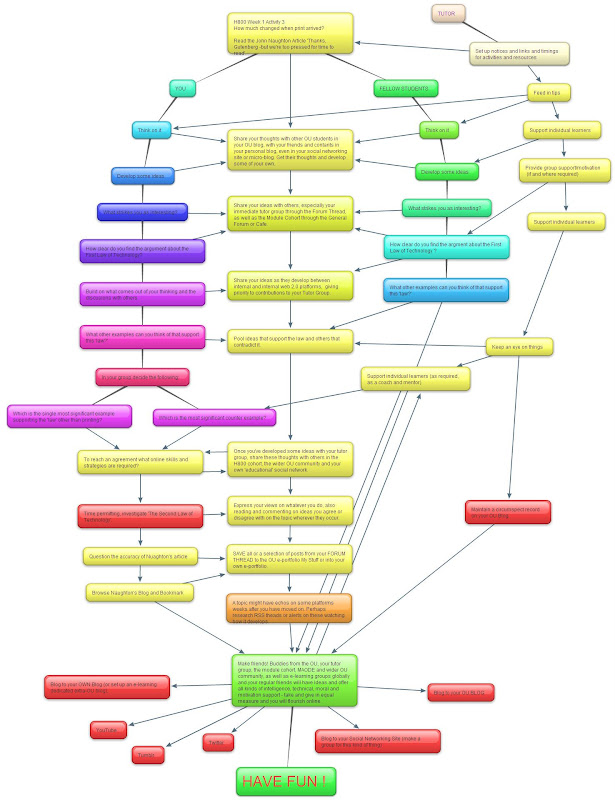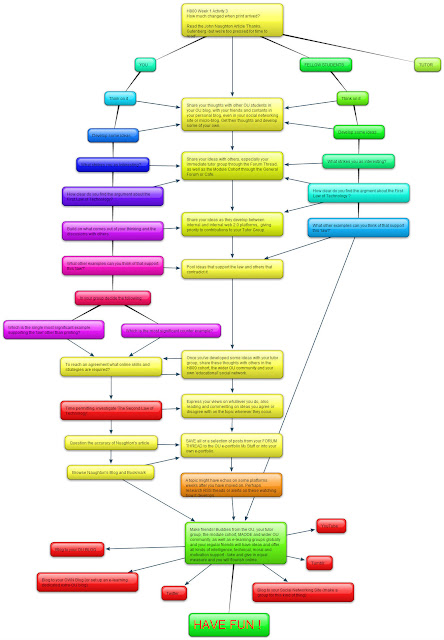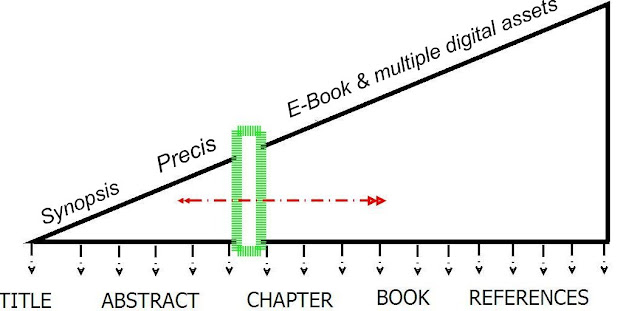I will be at CAL ’09 next week in Brighton, and am looking forward to it, in particular some of the sessions and papers which include work from the JISC Curriculum design call. For example, the “challenges of the design pattern paradigm” session and other learning design papers/session. In the meantime I thought I’d put up the poster that my colleagues and I have put together, This poster entitled “Visualising the process and and products of learning design” will be presented at CAL ’09.
It is a very short synopsis of the visualisation and representation work we’ve been doing here at the OU. A version of the poster itself is available for download (click on the image to see a low resoultion image of the poster, or on one of the links to see a higher resolution PDF at either A4 or A0 size):

Visualising the process and and products of learning design, A0 sze (pdf, 1.9 Mbyte),
Visualising the process and and products of learning design, A4 size (pdf, 1.1 Mbyte).
Also, a draft of the text of the poster (including the abstract and references) is available here.
Can visual representation work at the curriculum level?
Apart from the design patterns and learning design stuff, one of the other things I would like to explore whilst at the conference is if or how visual representations have been used at programme level (or above). As far as I’m aware, most visual representation work has focused on the activity or course level, and describes interactions involving students and teachers. But what about the curriculum level? I’m keen to talk to anyone working in this area: please do contact me if you are, or add a comment below, thanks  " src="http://www.open.ac.uk/blogs/brasherblog/wp-includes/images/smilies/icon_smile.gif" />
" src="http://www.open.ac.uk/blogs/brasherblog/wp-includes/images/smilies/icon_smile.gif" />
CAL ’09 poster text
Abstract
Teachers and media developers go through a complex decision making process when designing new learning experiences – working towards an effective pedagogical mix, combining resources, tools, student and tutor support. For an individual media developer or teacher, the process of creating a visual map of a learning activity clarifies their own understanding of the mix. For teams comprised of individuals focused on different aspects, a visual representation supports communication about issues that need to be resolved before the activity is delivered to students.
This paper focuses on the development of CompendiumLD, a particular strand of work within the OU Learning Design Initiative. CompendiumLD is a tool to represent and visualise learning designs; it is an adaptation of Compendium, an existing knowledge mapping tool. CompendiumLD has been developed iteratively, informed by evidence gathered through a series of interviews with academics, and tested through a series of faculty based workshops. Development has proceeded from changes in the set of icons used to represent components of learning activities, through to specific functionality to support the design of learning activities. This functionality includes context specific learning design help and a set of visual design templates.
Findings to date indicate that most users find the tool easy to use, that it makes the process more explicit and provides a useful vehicle for sharing design ideas with others. Some users are interested in its potential to support both the process of learning design and the production of maps for use by students.
Recently introduced features include (1) the facility to specify times that students and tutors will spend on specific tasks, producing a running total displayed on the user interface and (2) support for transclusions (intended to help designers identify reuse of e.g. tasks or learning objectives. Initial evaluations of these new features will be discussed.
1 Introduction
A learning activity can be conceptualised as a specific interaction of learner(s) with zero or more other(s) using specific tools and resources, orientated towards specific outcomes (Beetham, 2007). Evidence we have gathered indicates that designing learning activities is inherently messy, creative and iterative, and that choosing the best combination of tools, resources and tasks for a particular context is difficult (Conole et al., 2008). In the Open University and other distance universities, design is typically carried out by teams composed of people with a variety of specialist skills including academics, programmers, graphic designers, editors and project managers.
2 Aims
Our aim is to research, design and implement a range of tools to support individuals to design effective learning activities, and to enhance the effectiveness of design teams.
One approach we have taken is to apply the concept of ‘knowledge cartography’ to learning design, building on previous work in this area including other visual representations of learning designs (e.g. UML activity diagrams, LAMS). This has led to the development of a software tool CompendiumLD through which we are exploiting two aspects of mapping, the product and the process.
- As products maps can visually represent complex relationships between objects, which highlight key elements and connections for a particular purpose
- Creating a map forces a person to externalise their understanding of the situation, and this process clarifies their understanding of the situation
(Okada, Buckingham Shum, & Sherborne, 2008).
Design processes
In our research to date we have studied how design is carried out by individuals and teams within the iterative design cycle which occurs before courses are launched.
We will be studying how CompendiumLD can be used by teachers to deliver teaching activities, and how it can be used to evaluate the design of activities.
Design products
Snapshots from the design process
The learning design nodes are on the left hand side: these can be dragged and droped onto the working area. Learning design nodes include
Learning activity
Learning outcome
The nodes can be connected by dragging between them.
Double-clicking on a learning activity opens it
A screen grab of CompendiumLD showing the main working area labelled “Andrew Brasher’s Home Window”.
Context sensitive prompts appear when nodes are added.
3 Evidence
Empirical evidence gathered to inform the development of CompendiumLD includes the collection of user requirements (Nixon, 2007), case studies (Wilson, 2007), 12 semi-structured in-depth interviews, and evaluation of workshops and focus groups (Cross, 2008). In January 2009 we began in-depth evaluation of holistic course design, which has and will involve studying course teams’ use of visual representations during the design process over a period of 9 months. Examples from our evidence base are shown as speech bubbles.
4 In use
Examples illustrating how CompendiumLD can be used within the design process are provided by snapshot 1 and snapshot 2. Snapshot 1 illustrates an early stage of the the design process, snapshot 2 a later stage when a more detailed description has been generated and some of the issues that arose in snapshot 1 have been resolved.
5 Conclusions and future work
The qualitative data we have gathered so far indicates that generating a visual representation helps to clarify designers’ intentions, and aids communication of those intentions. Continuation of the iterative improvement of the tools and methods we have developed is planned for 2009-10, including trials across a range of UK universities. So far our work has focused on the representation of learning activities within a course or module. We will be looking at applying visual representations at different levels, e.g. across degree programmes, and requirements gathering workshops to inform this are planned for later in 2009.
References and further information
Full references for the citations in this poster are available from are available from http://www.open.ac.uk/blogs/brasherblog. Information about CompendiumLD is available from http://compendiumld.open.ac.uk.
Beetham, H. (2007). An approach to learning activity design. In H. Beetham & R. Sharpe (Eds.), Rethinking pedagogy for a digital age: designing and delivering e-learning (pp. 26-40). Oxford: Routledge.
Conole, G., Brasher, A., Cross, S., Weller, M., Clark, P., & White, J. (2008). Visualising learning design to foster and support good practice and creativity. Educational Media International.
Cross, S., Conole, G., Clark, P., Brasher, A., & Weller, M. . (2008). Mapping a landscape of Learning Design: Identifying key trends in current practice at the Open University. Paper presented at the LAMS Conference.
Nixon, S. (2007). LD project final report – final report of the LD VLE programme work. Milton Keynes: The Open University.
Okada, A., Buckingham Shum, S., & Sherborne, T. (2008). Knowledge Cartography: Software Tools and Mapping Techniques: Springer.
Wilson, P. (2007). Progress report on capturing eLearning case studies (Internal report). Milton Keynes: The Open University.






